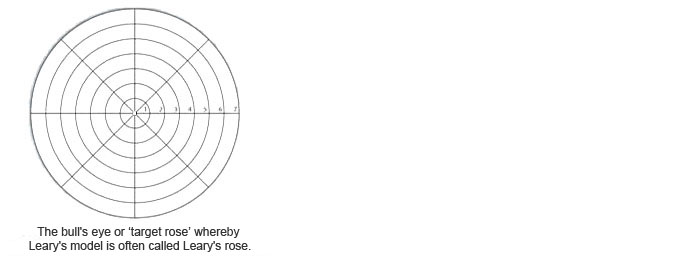Circumplex History
The brilliant clinical psychologist Timothy Leary (1920-1996) was known mainly for the model popularly referred to as the interpersonal circumplex, Leary’s circle, or in the Dutch tradition--Leary’s rose.
In addition to his work on the interpersonal circumplex and psychedelic drugs, Leary also worked on themes such as the effects of the various forms of psychotherapy, imagination and fantasy, personality and personality testing, and group therapy. Some of his experiments were serious or exploratory, but others were weird. After the period of his interest in science, there was a clear turning point in his life from 1960 onwards. He became associated with less evidence-based matters, such as transactional analysis, NLP, near-death experiences, and several esoteric issues, including occult eastern religions.
Before he fell out of favour with the authorities due to his experiments with drugs, Leary held various posts, including assistant professor at University of California Berkeley, director of The Kaiser Foundation Psychology Research Division (from where the interpersonal circumplex originated), and lecturer and researcher at Harvard University.
In the mid 1950s, Timothy Leary was director of a research team called The Kaiser Foundation Psychology Research Project (from where the interpersonal circumplex originated). Funded by The Kaiser Foundation and the United States Public Health Service, this team endeavoured to conduct pioneering empirical research into interpersonal variables; that is, the way in which people behave towards other people.
The team charted human behaviour in a two-dimensional space. This is now reproduced in a circular shape, but it is, in fact, a statistical model, namely a circumplex. The circular shape is created by 'a series of points the same distance from the centre and evenly spaced.' Since concentric circles are shaped like a bull’s eye or rose (see the figure below), in Dutch-speaking Europe it is referred to as the Roos van Leary. It was only through the publication of his book that the rose acquired a reputation. However, Leary himself never used the word rose in his book.

Leary’s controversial and eccentric life meant that his earlier scientific work was taken less seriously and at a certain point in time threatened to drift into oblivion.
The Motivation for Leary’s Research
As an assistant professor, Leary started research into the effects of psychotherapy and group dynamic processes; this probably gave him the idea of researching and measuring personality.
The initial goal of the research project was to create a system where psychologists rather than psychiatrists would be able to deal with psychological factors that exacerbated a physical illness. Soon it became apparent that Leary had more interest in research than in practical psychological consultations. Using data selected from more than 5,000 cases in the Kaiser Foundation medical system, Leary’s group developed the interpersonal theory.
Leary referred explicitly to people like Sullivan, Mead, and Sapir.
Harry Stack Sullivan (1892-1949) was a psychiatrist who abandoned Freud’s ideas and ascribed an important role to people’s relationships or social networks. Leary refers to his work as interpersonal relations theory.
George Herbert Mead (1863-1931) was a sociologist with more or less the same ideas as Sullivan and he exerted great influence–his ideas are known as Social Behaviourism or the Social Theory of Mind.
Edward Sapir (1884-1939) was an anthropologist and linguist to whom Leary acknowledged that he was also indebted.
Their work inspired Leary and his team to try to chart interpersonal human behaviour and personality dimensions intelligibly. Leary clearly stated “interpersonal behavior defines the most important dimensions of personality” (Leary, 1957, p. 12).
Another factor that led to this research was Leary’s dissatisfaction with the theory of radical behaviourism, which defined human behaviour purely as a consequence of situational influences.
The First Circumplex Publications
Around 1949, the first diagram was made in an attempt to chart interactions between people during group therapy (LaForge, 1985).
Scientific publications reveal that the diagram was the result of several evening brainstorming sessions on mutual associations between the interpersonal mechanisms. Although the diagram was not circular, the two main factors (axes) were rather intuitively labelled with the characterisations “Dominance & Submission” (vertical, later Agency) and “Hate & Love” (horizontal, later Communion). The words “Deprivingness,” “Nurturance,” “Dependingness,” and “Demandingness” also appear on the diagram. Articles on the subject followed in 1951 and 1954. In 1951, a more mathematical working method was outlined in a joint article (Freedman et al., 1951).
The presentation of human interaction in the shape of a circle was first published in 1954 (La Forge et al., 1954). It consisted of 16 interpersonal mechanisms (e.g., Dominate, Punish, Love, and Trust) with three levels of intensity: mild, average or appropriate, and intense or extreme.
However, it was Louis Guttman who used the term circumplex in a publication for the first time in 1954. At that time, there was no hint of the interpersonal circumplex, but Timothy Leary’s group did take this expression on board.
In 1957, Timothy Leary’s book Interpersonal Diagnosis of Personality appeared in print. It was based on the research done by his core team of four people, assisted by other psychologists and employees. By that time, of course, the circular shaped presentation of interpersonal behaviour was common practice.
It was an extraordinary book as it was extolled by the American Psychological Association (APA) in 1957 as the best book on psychotherapy.